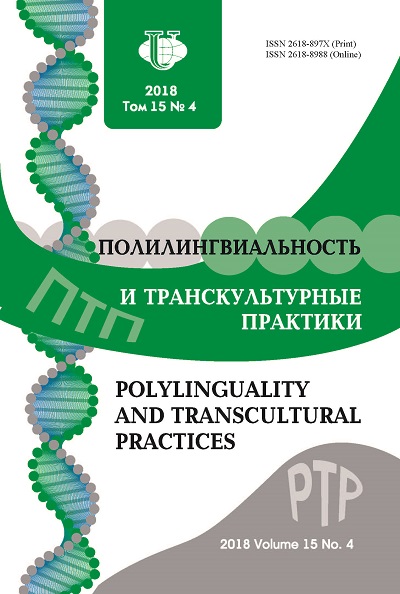Gender Specificity of the Evaluation Strategy of the Association of Russian Native Speakers: Quantitative Aspect
- Authors: Chernishova E.B.1
-
Affiliations:
- Borisoglebsk branch of Voronezh State University
- Issue: Vol 15, No 4 (2018)
- Pages: 554-563
- Section: LANGUAGE CONSCIOUSNESS
- URL: https://journals.rudn.ru/polylinguality/article/view/20244
- DOI: https://doi.org/10.22363/2618-897X-2018-15-4-554-563
Cite item
Full Text
Abstract
The article deals with the actual problem of gender influence on the course of associative processes. The aim of the work is to identify and describe the gender specifics of the evaluation strategy of the association. The conclusions are based on the material of a free associative experiment with multiple reactions of examinees, conducted by the author in 2016 with female and male native speakers of Russian language aged 7 to 25 years. This type of experiment showed that the evaluation reactions mainly have the second and third rank in the associative series. The gender specificity of the evaluation association is registered in response to each proposed word stimulus, most vividly - to words-stimuli, strength, joy, peace. Evaluative reactions predominate in the associative fields of nuclear units among female examinees, first of all with girls 7-10 years and young women 18-25 years old. Thus, the free associative experiment with multiple reactions of the examinees makes it possible to obtain the most representative experimental material, including identifying gender features of the associative mechanism.
About the authors
Elena Borisovnais Chernishova
Borisoglebsk branch of Voronezh State University
Author for correspondence.
Email: elenachernishova@yandex.ru
PhD in Philology, Associate Professor, department of primary and secondary professional education of tekhnologo-pedagogical faculty Borisoglebsk branch of Voronezh State University
43, Narodnaya str., Borisoglebsk, 397160, Russian FederationReferences
- Harrold, R.M., Burke, D., Peters, L. eds. 1987. Word Association Norms for Young and Older Adults / // Social and Behavioral Science Documents, 1987. Vol. 17(2). [электронный ресурс]. http://lcs.pomona.edu/cogaging/materials/research/Word_Association.pdf (дата обращения: 15.03.2018).
- Nelson, D.L. 2000. What is free association and what does it measure? Memory & Cognition. Vol. 28. Florida.
- Nelson, D.L. 2004. The University of South Florida free association, rhyme, and word fragment norms. Journal of Experimental Psychology: Learning, Memory and Cognition. Vol. 30. Tampa.
- Ufimtseva, N.V. 2004. Predislovie. Slavyanskii assotsiativnyi slovar’: rus., belorus., bolg., ukr. [Preface. Slavic associative dictionary: Rus., Bel., Bolg., Ukr], 3—9. Moscow: Mosc. state linguist. Univ. publ. Print. (in Russ.)
- Goroshko, E.I. 2003. Jazykovoe soznanie: gendernaja paradigma [Language consciousness: a gender paradigm]. Moscow-Har’kov: ID INZhJeK publ. Print. (in Russ.)
- Goroshko, E.I., Kirilina, A.V 1999. Gendernye issledovanija v lingvistike segodnja [Gender studies in linguistics today]. Gendernye issledovanija. Har’kovskij centr gendernyh issledovanij. Moscow: «Chelovek & Kar’era» publ. 2: 234—241. Print. (in Russ.)
- Variyasova, E.V. 2012. Gender factor influence on association behavior of advertising communication participants. Bulletin of Tomsk state pedagogical University 10 (125): 151-153. Print. (in Russ.)
- Vozdvizhenskaya, A.V. 2014. Gendernyi aspekt assotsiativnogo reagirovaniya [Gender aspect of associative response]. Slovo i tekst: psikholingvisticheskii podkhod [Word and text: psycholinguistic approach] 14: 185—188. Tver’: Tver State University. Print. (in Russ.)
- Vjazigina, N.V. 2009. Associativnaja struktura jazykovogo soznanija v gendernom izmerenii (jeksperimental’noe issledovanie) [Associative structure of language consciousness in the gender dimension (experimental research)] // Trudy molodyh uchenyh Altajskogo gosudarstvennogo universiteta: Materialy XXXVI nauchnoj konferencii studentov, magistrantov i aspirantov i uchashhihsja licejnyh klassov. Vyp. 6: 163—164. Barnaul: Izd-vo Alt. un-ta, Print. (in Russ.)
- Tokareva, E.N. 2005. Specifika vyrazhenija ocenki v gendernom diskurse (na materiale sovr. angl. jaz) [Specificity of the evaluation expression in gender discourse (on the basis of modern English)]: PhD Dis. Ufa: BashSU. Print. (in Russ.)
- Cherepanov, I.Y. 2017. Influence of gender factor on respondents’ responses in associative experiment // Voprosy psikholingvistiki 3 (33): 202—217.
- Jachnaja, T.A. 2014. Vybor strategii associirovanija (gendernyj aspekt) [The choice of an association strategy (gender aspect)] // Trudy BGTU. Serija 5: Politologija, filosofija, istorija, filologija 5 (169): 183—185. Minsk: BGTU publ. Print. (in Russ.).
- Karaulov, Yu.N. 1999. Aktivnaya grammatika i assotsiativno-verbal’naya set’ [Active grammar and associative-verbal network]. Moscow: Institut russkogo yazyka RAN publ. Print. (in Russ.)
- Sdobnova, A.P. 2015. Leksikon shkol’nika kak dinamicheskaya sistema [The vocabulary of the student as a dynamic system]. Saratov: Izd-vo Saratovskogo un-ta publ. Print. (in Russ.)
- Klenova, A.V. 2007. Otsenochnye smysly v assotsiativnom slovare (na materiale assotsiativnogo slovarya shkol’nikov Saratova i Saratovskoi oblasti) [Evaluation of associative meanings in the dictionary (on the material of associative vocabulary of schoolchildren of Saratov and Saratov region)]. Doc. Dis. Saratov. Print. (in Russ.)
- Zhelezovskaya, N.L. 2015. Etnoyazykovaya spetsifika emotsional’no-otsenochnykh edinits russkikh, belorusskikh i amerikanskikh assotsiativnykh polei «chelovek» [Ethno-linguistic specificity of emotional-evaluative units of Russian, Belarusian and American associative fields «human»]. Izvestiya Gomel’skogo gosudarstvennogo universiteta imeni F. Skoriny 1 (88): 89—95. Print. (in Russ.)
- Ufimtseva, N.V. 2017. Yadro yazykovogo soznaniya [The core of linguistic consciousness]. (Neo) psikholingvistika (psikho)lingvokul’turologiya: novye nauki o cheloveke govoryashchem [(Neo) psycholinguistics (psycho) linguoculturology: new sciences about the person speaking], edited by V.V. Krasnykh, 40—42. Moscow: Gnozis publ. Print. (in Russ.)
- Gol’din, V.E., Sdobnova, A.P., Mart’yanov, A.O. 2011. Russkii assotsiativnyi slovar’: assotsiativnye reaktsii shkol’nikov 1—11 klassov: v 2 t. T. 1. Ot stimula k reaktsii [Russian associative dictionary: associative reactions of pupils of 1—11 classes: in 2 Vol. Vol. 1. From stimulus to reaction]. Saratov: Izd-vo Saratovskogo un-ta publ. Print. (in Russ.)
- Gol’din, V.E., Sdobnova, A.P., Mart’yanov, A.O. 2011. Russkii assotsiativnyi slovar’: assotsiativnye reaktsii shkol’nikov 1—11 klassov: v 2 t. T. 2. Ot reaktsii k stimulu. Ch. 1. A-N [Russian associative dictionary: associative reactions of pupils of 1—11 classes: in 2 Vol. Vol. 2. From reaction to stimulus. Part 1]. Saratov: Izd-vo Saratovskogo un-ta publ. Print. (in Russ.)
- Gol’din, V.E., Sdobnova, A.P., Mart’yanov, A.O. 2011. Russkii assotsiativnyi slovar’: assotsiativnye reaktsii shkol’nikov 1—11 klassov: v 2 t. T. 2. Ot reaktsii k stimulu. Ch. 2. O-Ya [Russian associative dictionary: associative reactions of pupils of 1—11 classes: in 2 Vol. Vol. 2. From reaction to stimulus. Part 2]. Saratov: Izd-vo Saratovskogo un-ta publ. Print. (in Russ.)















